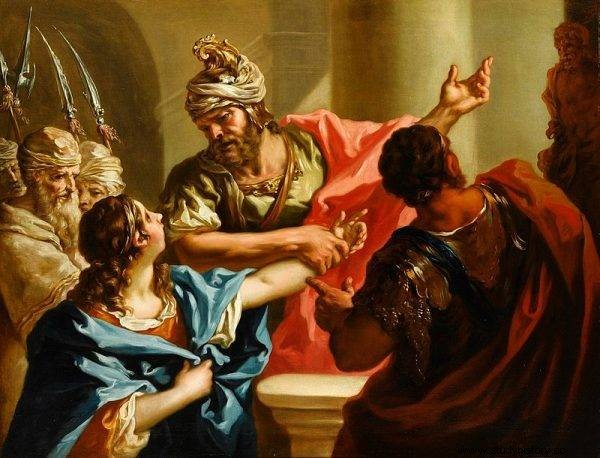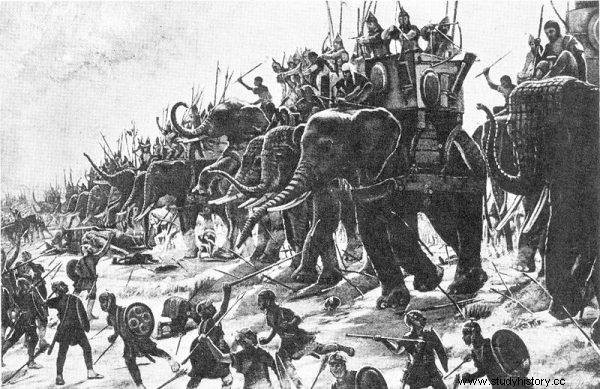"I am being dismissed by those people who have tried for a long time to force me to come back because they did not send me meals and money. So Hannibal won not the Roman nation, beaten so many times by me, but the Carthaginian senate by envious intrigues, ”the Carthaginian leader bluntly commented on his dismissal from Italy. Could he have already sensed what the struggle with Rome would end with? After all, the Second Punic War was still going on.
Activities in the course of started in 218 BCE The Second Punic War reached "a scale rarely seen before the modern era," notes British historian Adrian Goldsworthy in his book The Fall of Carthage. Punic Wars 265-146 BCE
Both sides deployed armies of hundreds of thousands of soldiers that fought from the Iberian Peninsula through Italy and Sicily to the sands of North Africa. Civilians were stormed by cities and at "the hands of plundering bands that ravaged the fields and villages controlled by the other side" Emphasizes Goldsworthy. When we add to this the victims of disease and hunger, and the multitudes of unfortunates in captivity, we see a truly Dantean picture of the world of that time.
Master of the blitzkrieg
One of the main perpetrators of this all-out war was Hannibal, who surprised the Romans by relocating hostilities to the Apennine Peninsula. And his initial streak of success in the battles of Ticinus, Trebia, Lake Trasimeno and finally Cannae brought the Eternal City to the brink of collapse in just two years.
His blitzkrieg claimed, according to various estimates, from 80,000 to 100,000. fallen and captured soldiers of the Roman republic - which at that time constituted nearly a third of its military strength.
Honorary cause
Nevertheless, painful from the bloody losses in the field "was a stain on the honor of an opponent who cannot defend his territory" - he writes in The Fall of Carthage Goldsworthy. Moreover, as the British historian notes: "A state unable to defend its allies lost not only their respect, but often also themselves."

One of the main perpetrators of this all-out war was Hannibal, who surprised the Romans by relocating hostilities to the Apennine Peninsula.
As a result, both Rome and Carthage had to deal with disloyalty among the peoples of Spain, Sicily and Italy. Ultimately, however, in the course of the further struggles of the Second Punic War, Hannibal felt it most strongly. According to Goldsworthy:
his helplessness in the face of the Roman invasions of the Italian peoples who joined him in alliance became the main reason for their inevitable drift back under the wing of the recent hegemon.
All in vain
In the years that followed, Hannibal's situation became more and more difficult. Especially that for unknown reasons after the bloodbath given to the Romans at Cannae, the Carthaginian commander did not move to conquer the Eternal City.
According to the Roman historian Livy, one of Hannibal's commanders was to encourage him after the battle not to delay and to march towards Rome. "That you may know what this battle has accomplished, on the fifth day you will feast victorious on the Capitol," he tirelessly but unsuccessfully persuaded his leader. The proud Barkida remained unmoved. As Adrian Goldsworthy points out:
Hannibal in 216 didn't even try to attack the city. For some time he stayed at Cannae, regenerating his strength after the campaign and the heavy losses he had suffered. He himself was very actively involved in the battle and was almost certainly physically and mentally exhausted.

The text was created, among others based on Adrian Goldsworthy's book The Fall of Carthage. A History of the Punic Wars ”, which has just been released by Rebis.
Roma ante portas!
His lack of decisive action changed the course of history. While the moment of breathing after the bloody blitzkrieg allowed the republic from the Tiber to proceed to offensive actions, the Punic leader was condemned to his own strength. He could only envy the Romans for their determination to continue the war.
As we read in The Fall of Carthage : "There were even calls to the domestic slaves of the citizens, promising freedom and civil rights after leaving the service to those who wish to fight the Carthaginians. ”
Meanwhile, his calls for reinforcements from Carthage remained unanswered. So soon the victories were over, and the war was exhausted. To make matters worse, in 204 the Romans arrived in Africa, where along with most of the Numidian mercenaries - Hannibal's former allies - they set off towards the gates of Carthage.
In this situation, it is not surprising that Livius describes the "hardly held back tears" of the great Barkid, when with a heavy heart and a corps of 15,000 of his veterans, he left Italy at the call of his hometown. He probably knew then that he could not win the war with Rome. All that was left for him to do was fight with dignity.
The heavyweight case
Shortly after landing in the fall of 203, he organized an army of over 50,000 on his native land. This time, in the presence of a small cavalry (it was especially painful to switch to the Roman side of most of the excellent Numidian cavalry) Hannibal strengthened his troops with the number of 80 war elephants, unprecedented in his campaigns.

Hannibal strengthened his troops with an unprecedented number of 80 battle elephants in his campaigns.
The animal formations seen in the Hellenistic rulers perfectly matched the character of the multi-ethnic Punic forces. The Carthaginians probably used the African forest elephants available on the spot. Their smaller stature than the Indian cousins in the service of the Hellenes, however, meant that they did not carry shooters on their backs. "The primary weapon was the elephant itself, making use of its mass and strength to terrify or crush its opponent" - emphasizes Goldsworthy.
Unfortunately, despite their advantages, "they had a tendency to panic, and then trampled both their own and their enemies" - we read in The Fall of Carthage . Hannibal must have been aware of the handicaps of the fighting beasts, but they were the source of victory nevertheless.
Zama - trampled dreams
The opportunity to verify these expectations appeared on October 19, 202 on the vast plain near Zama, southwest of Carthage. The Punic commander knew that his army was not ready for a general battle (many soldiers had never fought yet). However, he could not avoid the fight forever and accepted the challenge of the Roman leader Publius Cornelius Scipio, famous in Europe.
Hoping to make peace without bloodshed, Hannibal met his adversary on October 18th. Scipio, believing in the invincibility of his armies of nearly 40,000, was nevertheless irreconcilable.
The next day, the enemy armies waited in silence for the signal to attack. As soon as the cavalry of both sides ended in the foreground, the first to attack were Hannibal's elephants . But as the Punic tanks were gaining momentum, as Adrian Goldsworthy writes:"here and there, the soldiers raised their battle shouts and trumpets - as always before battle, to show confidence and take it away from the enemy."

Before the sun went down, Hannibal's massacred army ceased to exist properly, and over 20,000 people were stained with blood. the fallen Carthage had to ask for peace.
At that moment, the darkest dream of the brave Barkida came true - his elephants fell into panic. Frightened animals, instead of attacking the legionnaires, mostly turned back and, looking for a way out, trampled the ranks of their own riders standing on the wings. And after those who managed to escape the rushing colossi, formations of the Scipio cavalry rushed in pursuit.
Hannibal still placed his trust in those elephants that continued to charge into Roman positions. However, he did not live to see the massacre of the legionary ranks. The rushing animals, pushed back by light-armed velites, ran through the corridors carefully left by Scipio in the Roman lines and in the back were eliminated from the fight.
History goes on in a circle
Hannibal, stripped of his main assets - elephants and cavalry - was left with only a frontal engagement with the Scipio maniples. As Polybiusz wrote, "[...] both phalanxes moved towards each other with measured and proud steps, except for those who came with Hannibal from Italy". And as Goldsworthy notes - "the fighters did not waste much time throwing spears at each other, but quickly came into direct contact" .
This enthusiasm, however, was not enough for the first two Punic lines to break the iron formation of the legions. Moreover, at some point the Carthaginians left their fighting spirit and began to withdraw towards the last line of their troops - the Hannibal veterans. They immediately launched to attack, facing the panicked refugees along the way. However, they quickly caught up with the Roman phalanx, holding back its accelerating advance.
The long and arduous fight was finally decided by the appearance of returning from the pursuit of the Punic cavalry of the Roman cavalry formation. They attacked "the Punians from behind, inflicting as heavy losses on them as they did years ago against the Romans at the Trebia and at Cannae," concludes Adrian Goldsworthy in his book.
Before the sun went down, Hannibal's massacred army ceased to exist properly, and over 20,000 people were stained with blood. the fallen Carthage had to ask for peace.
